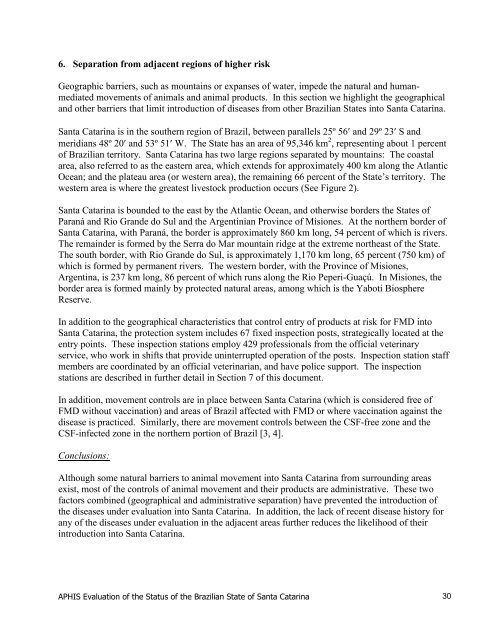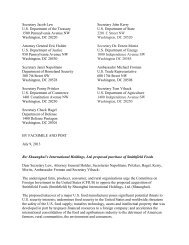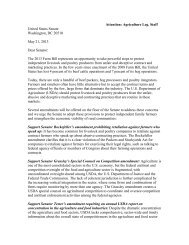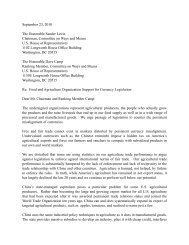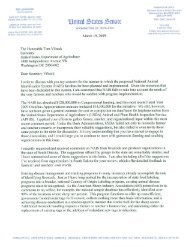Exhibit 8, 100416 Brazil FMD Risk Evaluation - R-Calf
Exhibit 8, 100416 Brazil FMD Risk Evaluation - R-Calf
Exhibit 8, 100416 Brazil FMD Risk Evaluation - R-Calf
Create successful ePaper yourself
Turn your PDF publications into a flip-book with our unique Google optimized e-Paper software.
6. Separation from adjacent regions of higher risk<br />
Geographic barriers, such as mountains or expanses of water, impede the natural and humanmediated<br />
movements of animals and animal products. In this section we highlight the geographical<br />
and other barriers that limit introduction of diseases from other <strong>Brazil</strong>ian States into Santa Catarina.<br />
Santa Catarina is in the southern region of <strong>Brazil</strong>, between parallels 25º 56 and 29º 23 S and<br />
meridians 48º 20 and 53º 51 W. The State has an area of 95,346 km 2 , representing about 1 percent<br />
of <strong>Brazil</strong>ian territory. Santa Catarina has two large regions separated by mountains: The coastal<br />
area, also referred to as the eastern area, which extends for approximately 400 km along the Atlantic<br />
Ocean; and the plateau area (or western area), the remaining 66 percent of the State’s territory. The<br />
western area is where the greatest livestock production occurs (See Figure 2).<br />
Santa Catarina is bounded to the east by the Atlantic Ocean, and otherwise borders the States of<br />
Paraná and Rio Grande do Sul and the Argentinian Province of Misiones. At the northern border of<br />
Santa Catarina, with Paraná, the border is approximately 860 km long, 54 percent of which is rivers.<br />
The remainder is formed by the Serra do Mar mountain ridge at the extreme northeast of the State.<br />
The south border, with Rio Grande do Sul, is approximately 1,170 km long, 65 percent (750 km) of<br />
which is formed by permanent rivers. The western border, with the Province of Misiones,<br />
Argentina, is 237 km long, 86 percent of which runs along the Rio Peperi-Guaçú. In Misiones, the<br />
border area is formed mainly by protected natural areas, among which is the Yaboti Biosphere<br />
Reserve.<br />
In addition to the geographical characteristics that control entry of products at risk for <strong>FMD</strong> into<br />
Santa Catarina, the protection system includes 67 fixed inspection posts, strategically located at the<br />
entry points. These inspection stations employ 429 professionals from the official veterinary<br />
service, who work in shifts that provide uninterrupted operation of the posts. Inspection station staff<br />
members are coordinated by an official veterinarian, and have police support. The inspection<br />
stations are described in further detail in Section 7 of this document.<br />
In addition, movement controls are in place between Santa Catarina (which is considered free of<br />
<strong>FMD</strong> without vaccination) and areas of <strong>Brazil</strong> affected with <strong>FMD</strong> or where vaccination against the<br />
disease is practiced. Similarly, there are movement controls between the CSF-free zone and the<br />
CSF-infected zone in the northern portion of <strong>Brazil</strong> [3, 4].<br />
Conclusions:<br />
Although some natural barriers to animal movement into Santa Catarina from surrounding areas<br />
exist, most of the controls of animal movement and their products are administrative. These two<br />
factors combined (geographical and administrative separation) have prevented the introduction of<br />
the diseases under evaluation into Santa Catarina. In addition, the lack of recent disease history for<br />
any of the diseases under evaluation in the adjacent areas further reduces the likelihood of their<br />
introduction into Santa Catarina.<br />
APHIS <strong>Evaluation</strong> of the Status of the <strong>Brazil</strong>ian State of Santa Catarina 30


